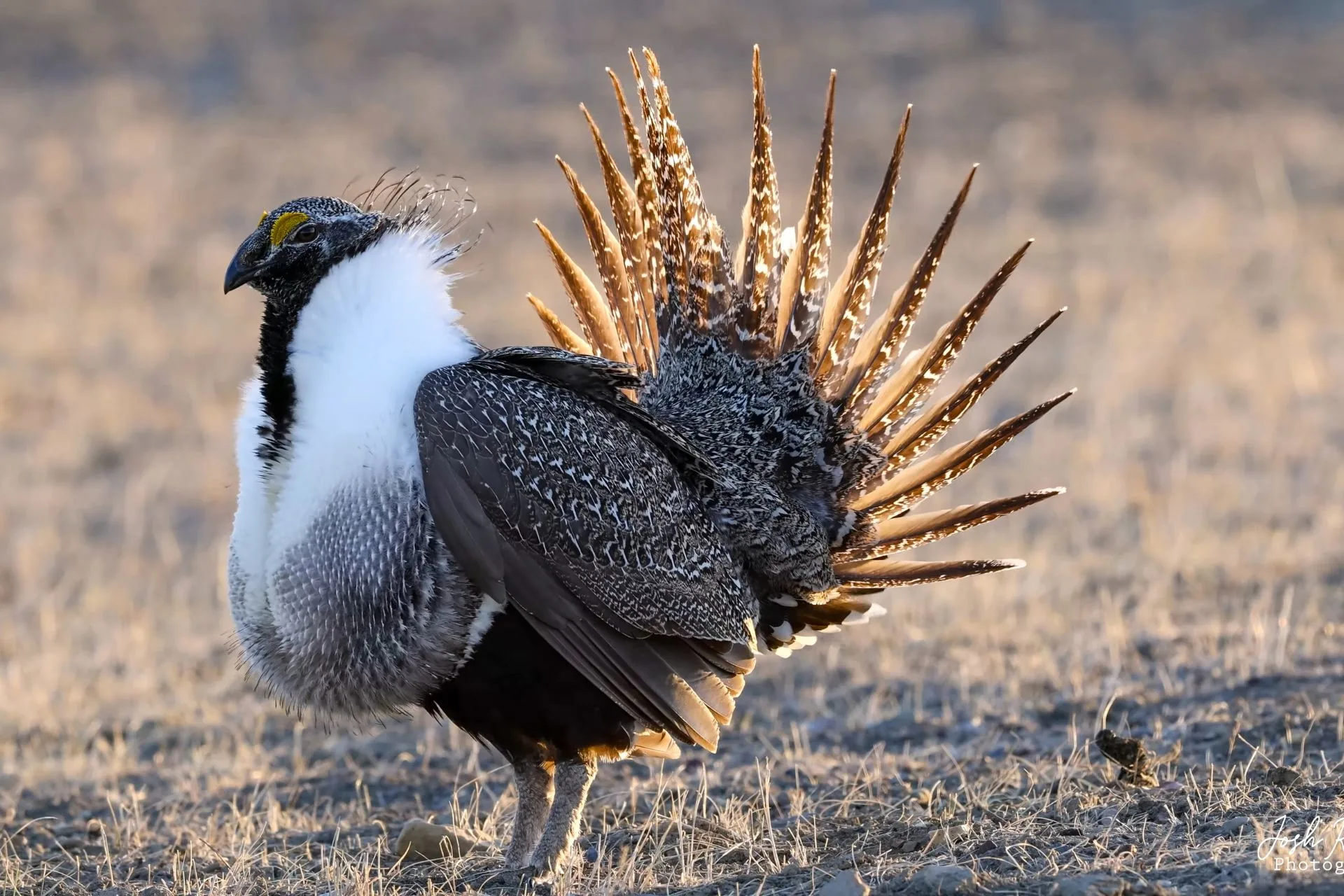BRETT FRENCH | bfrench@billingsgazette.com
A $1.2 million conservation easement to protect sage grouse habitat on 4,417 acres of the Lehfeldt property north of Lavina was unanimously approved on Monday, but not before the Montana Sage Grouse Oversight Team wrestled with how much to pay and the expenditure’s impact on the program’s balance.
“We’re here because we need some help, folks, and we can help you,” John Lehfeldt told the team in a Sept. 9 meeting.
In return for granting a permanent easement under the Sage Grouse Habitat Conservation Program, he said the family was giving up a “long-term possible value” while still keeping the property in production as grazing land for the sheep they raise.
“I think with our sheep grazing, and with the herders and us being out there all the time, we’re helping mitigate predation and we’re keeping track (of sage grouse),” Erik Lehfeldt told the team in September.
His family, Erik noted, has been in ag production for 140 years.
“It’s all really good habitat on their place and around the surrounding place,” Ashley Taylor, a Fish, Wildlife & Parks’ wildlife biologist told Montana Sage Grouse Oversight Team (MSGOT) in September. “It’s intact sagebrush habitat. There’s good brood-rearing habitat.”
Taylor and Erik Lehfeldt also noted that development pressures are increasing in the area, including subdivision and one recently sold property that has been plowed.
Saving sage grouse
The Montana Sage Grouse Oversight Team was founded in 2015 as a way for the state to protect the threatened birds’ habitat through conservation easements and habitat projects. The idea was to prevent federal listing of the species as endangered, which could hamper development in the bird’s prairie home.
Last year there was a population of more than 48,700 sage grouse estimated in Montana, the lowest approximation since 2019. Estimates peaked in 2006 at more than 115,500 birds. Weather, predation and loss of habitat all contribute to population fluctuations.
Since its creation, the team has authorized 19 easements and three term leases costing more than $12.71 million. The easements have resulted in the conservation of about 132,000 acres.
The fund was initially financed by a $10 million appropriation from the Montana Legislature. Developers for projects like oil and gas, power lines and wind farms could either offset their impact to sage grouse habitat by paying into the fund or by conducting conservation projects.
The state money was gone by 2020, meaning all future easements or habitat projects have to be funded by industry payments. The Stewardship Account currently holds more than $4.34 million.
Development credit
In 2020, the Clearwater Wind project — at the time proposed in Rosebud, Custer and Garfield counties — objected to the MSGOT’s calculated $11 million mitigation payment. An attorney for the developer, NextEra Energy Resources, protested the cost arguing it was so “extreme and disproportionate” that it threatened the economic viability of the wind farms.
“In the case of the Clearwater Wind Project, the company argued that the proposed development provided a benefit to the state of ‘increased economic activity and employment in rural Montana counties, as well as the addition of 750 megawatts of renewable energy and a major outgoing transmission line,’” explained KarenDe Herman, a Department of Natural Resources and Conservation communications specialist.
In response, MSGOT granted Clearwater a waiver of 236,976 debits reducing the company’s payment by about $1.6 million to a recalculated $4 million, Herman said. The initial debits MSGOT calculated for the projects was 1,667,703.
A Habitat Quantification Tool determines how many acres of sage grouse habitat is affected by a development. This loss is then converted into debits. Conversely, habitat restoration work can count as credits.
In 2018, the team had also created a calculation to decrease the higher costs associated with long-term development projects seeking MSGOT approval. The result has been that short-term projects, like a gravel pit, pay a higher percentage of their project’s cost in debits.
For example, a short-term project may get a 5% discount while a 50-year development could see a 30% discount on its mitigation obligations.
At the same time, MSGOT used a similar calculation to estimate payouts for credits. This calculation trimmed valuations for perpetual easements.
Payment calculations
In the Lehfeldt’s case, the changes resulted in a calculated payment of $537,512 for the perpetual easement which offered about 127,000 credits. The Montana Land Reliance, which would oversee the easement, was asking MSGOT for more than $1.44 million.
As a compromise, a third option was proposed by MSGOT that would pay out more than $950,600.
Sen. Denley Loge, R-St. Regis, advocated a fourth option of paying out $1.2 million for the easement. Loge is one of nine MSGOT members.
“I think this is one of the best … potential projects in Montana because of the core habitat and the connectivity,” Loge said. “There’s a lot of great things about this property.”
His proposal initially came with a caveat, allowing the Lehfeldts and Montana Land Reliance the option to seek other conservation funding to offset the difference.
But Brad Hansen, representing the Montana Land Reliance, said previous easement assistance was largely reliant on federal dollars, much of it coming from the Natural Resources Conservation Service through the Agricultural Land Easement program, or ALE. ALE could provide up to 50% of the fair market value for easements to protect farm and ranch lands from development.
The Inflation Reduction Act, passed in 2022, included $1.4 billion for such programs that fell under the Agricultural Conservation Easement Program’s umbrella, just a portion of the $19.5 billion authorized for ag conservation programs.
Under the Trump administration, the allocation to the Agricultural Conservation Easement Program this year was only $500 million. Next year, the program is projected to receive $625 million.
“Last year, the total statewide ask was $90 million for ALE, and there was a total of $15 (million) that Montana received,” Hansen said. “So the likelihood of the Lehfeldt project getting funded through ALE is, I have no idea, and those projects take about two years to complete.”
Land Reliance perspective
Hansen called Montana’s program the “gold standard” for sage grouse habitat protection at a time when the Bureau of Land Management is being ordered by the Trump administration to rewrite resource plans favoring industry and development over recreation and wildlife habitat.
With three generations of the Lehfeldt family attending the September MSGOT meeting, Hansen noted easements like the one approved could keep their fourth generation on the ranch.
He also criticized waivers given to industry in the past, saying it has compromised the sage grouse habitat program’s ability to fairly compensate landowners for easements.
“It sends a clear message to the Montana Land Reliance that the program may not have the appetite to fund conservation at the ask, so it would not incentivize us to bring future projects, knowing that the program simply can’t pay what it costs,” he said.
“During the first three grant cycles MSGOT was paying the ask based on the easement value, but most of those included matching funds,” the DNRC’s Herman wrote in an email. “In 2022 MSGOT elected to limit what they would pay to $13 per credit.”
Diminishing stewardship account
Although Loge, a western Montana rancher, proposed the higher payout, he also voiced concerns about the impact of the easement’s cost on the program’s future funding.
“Historically, the stewardship account has struggled to cover the impacts from construction phases of development projects, but with a fair job covering the operation phases of impacts,” according to Jamie McFadden, a geographic information systems analyst for DNRC.
Funding isn’t the only concern. In a 2020 Legislative Audit Division report, the program was criticized for not doing enough to improve existing habitat.
“There is some risk that, if conservation easements and term leases continue to be the most common form of credit project going forward, functional acres of sage grouse habitat will decrease, rather than be subject to no net loss,” the report noted.
The state is divided into four service areas. Currently the north-central and southeastern areas are operating at a credit deficit because the southwest and central areas are where 21 of the 22 conservation easements and leases have occurred.
In June, the DNRC issued a bid request for a detailed economic evaluation focusing specifically on the pricing structure and sustainability of the Sage Grouse Stewardship Account.
“The ultimate goal is to produce a thorough economic evaluation that can inform future policy and financial strategies for sage grouse habitat mitigation in Montana,” the request noted.
A contract for the work has not yet been signed. Once initiated, a DNRC spokesperson said it will take months for the report to be completed.

Lavina-area sage grouse habitat easement OK’d
Montana Outdoor Podcast
MT Outdoor Podcast Sneak Peek: Montana’s Ice Fishing Cheat Codes (ft. Captain Matt McComb)
Yes, You Can Outsmart Fish… Here’s How…
Rigger’s Out, Roger’s In–Montana’s Hunt Report Unleashed on the Montana Outdoor Podcast
This week, guest host Roger Fishwell takes the reins on the Montana Outdoor Podcast to break down fresh harvest numbers and hunter success stats from check stations across all seven Montana hunting regions.
MT Outdoor Podcast: The 30-Inch Walleye Obsession
When passion meets persistence, you get Ken, Amy, and the never-ending hunt for the 30-inch walleye…
MT Outdoor Podcast Sneak Peek: The 30-Inch Walleye Syndrome
Hooked on love and the hunt for a 30-incher — catch the sneak peek now!
MT Outdoor Podcast: This One is Gonna Get Spooky
This week on the Montana Outdoor Podcast, Downrigger Dale and guest Megan Buecking explore Montana’s haunted ghost towns—and the chilling stories that may keep you up at night…
Doubling Down with Region 4 and 7 on the Montana Outdoor Podcast
Discover Montana’s hunting secrets and one shocking antelope surprise as Downrigger Dale dives deep with wildlife managers from Regions 4 and 7…
Montana Tourney Trail
Montana Fishing Reports
Outdoor How-To
DIY Smoker: Filing Cabinet Turned Pitmaster
Don’t throw that old filing cabinet away…give it a new gig!
DIY: McFishing Rod…That Works
Proof you don’t need fancy gear to make the perfect catch…
How To Clean and Fillet Fresh-Caught Salmon
Check out these tips on how to clean and fillet your salmon!
MT Wildlife
The Deer Track Myth This Guy Says Everyone Keeps Getting Wrong
This guy is on a mission to prove this deer track myth wrong.
This Ram’s Horn Has a Story to Tell…But What Is It?
Although it is unclear what caused this horn damage, we do know of a few things that could have been the culprit…or part of the culprit.
Viral Footage of Man and Yellowstone National Park Wolves Confrontation
Man tests wildlife boundaries with wolves at YNP…and then what?
Viral Stories
Montana (Helena) Team Wins $500,000 in Cabo Fishing Tournament
A group of Montana anglers just proved that Big Sky Country breeds world-class fishermen — even in saltwater. Team Grey […]
Very Rare Footage of Wolverine Hunting Deer in Montana
Rare footage captures a wolverine hunting near Montana’s Ajax Mountain…
Bear’s Journey from Montana to the Savanna
From Montana’s peaks to Africa’s plains, this pup’s next job is guarding the herd to spare the fastest cat alive…
A Bison’s Final Steps at YNP’s Grand Prismatic Spring
Onlookers horrified at a bison took one wrong step into Yellowstone’s Grand Prismatic Spring…
Cow moose, 2 calves dead after encounter with angler
On the morning of June 14, 2025, Wyoming Game and Fish Department personnel received a report that a cow moose had been shot in a confrontation with an angler on the North Tongue River in the Bighorn National Forest near Bear Lodge Resort. When game wardens responded, they found the moose deceased from her injuries.
Montana FWP
Season tempered by mild weather in Region 2, harvest totals remain on track
The Rut Is Raging—but Hunter Success Isn’t What Anyone Predicted in Region 2…
Tips sought on white-tailed deer poached at Blue Mountain Recreation Area near Missoula
A White-Tailed Buck Was Left to Rot. The Race to Find the Shooter Is On….
Wild Game Recipes
The Secret Menu Item That’s Outrunning Chicken Wings
These wings just might steal the spotlight on snacks…
Cooking with Kokanee Quinn: Buffalo Pheasant Bombs Explode with Flavor
Flavor Bombs Incoming: These Buffalo Pheasant Crescents Go BOOM!!


